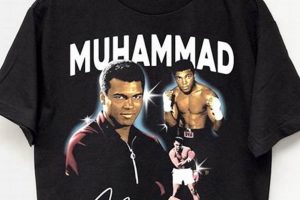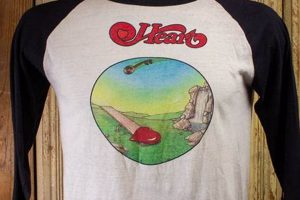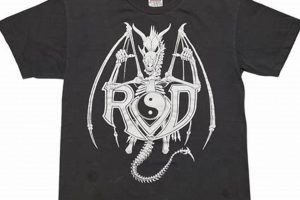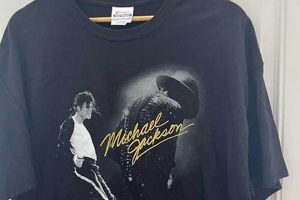Apparel featuring imagery or text related to the celebrated entertainer, Michael Jackson, produced during or representative of an earlier era, constitutes a specific category within collectible merchandise. These items often display design elements, manufacturing techniques, or branding indicative of their period of origin, distinguishing them from contemporary reproductions. An example would be a screen-printed garment from the 1980s promoting the “Thriller” album tour.
The significance of such articles of clothing lies in their ability to represent a tangible connection to a pivotal figure in popular culture history and a specific timeframe. These garments offer insights into music, fashion, and societal trends prevalent during Jackson’s career peaks. Owning such an item can represent a collector’s passion for the artist, a desire to preserve a piece of cultural history, or an appreciation for vintage aesthetics. Their scarcity and historical relevance often contribute to their value within the collectors’ market.
The following discussion will explore aspects such as identifying authentic examples, understanding factors that influence value, and detailing care and preservation methods to maintain their integrity. The market dynamics surrounding this specific genre of memorabilia will also be addressed.
Tips for Acquiring and Preserving Memorabilia
The following guidelines offer insight into navigating the market for collectible apparel and ensuring its longevity. Due diligence is crucial to a satisfactory purchase.
Tip 1: Authentication is Paramount: Prior to acquisition, thoroughly investigate the garment’s purported origin. Examine the label for manufacturer details, union markings, or copyright notices consistent with the claimed era. Compare design elements with known promotional materials from the period.
Tip 2: Condition Assessment is Critical: Carefully evaluate the state of the garment. Look for signs of wear such as fading, staining, holes, or seam separations. Understand that significant damage will negatively impact value. Note any repairs or alterations.
Tip 3: Fabric Composition Matters: Identify the materials used. Vintage items are often made from different fabrics than modern reproductions. Familiarize oneself with common textile blends used during the relevant period.
Tip 4: Print Quality Serves as an Indicator: Analyze the print quality. Screen-printing techniques differed in the past. Examine the ink thickness, texture, and detail of the image for consistency with period production methods. Digital printing is a strong indicator of a modern reproduction.
Tip 5: Understand Market Value: Research comparable sales to determine a fair price. Factors such as rarity, condition, size, and design influence value. Consult reputable auction houses or online marketplaces specializing in vintage apparel.
Tip 6: Proper Storage is Essential: To preserve the garment, store it in a cool, dry place away from direct sunlight. Use acid-free tissue paper to prevent creases and discoloration. Consider professional archival storage options for valuable items.
Tip 7: Cleaning Requires Caution: Avoid washing the garment unless absolutely necessary. When cleaning is required, hand-wash gently with a mild detergent designed for delicate fabrics. Avoid harsh chemicals or machine washing.
Adherence to these principles assists in making informed decisions and prolonging the lifespan of these unique articles, thereby preserving cultural heritage.
The subsequent section will provide an in-depth analysis of the economic factors affecting the desirability of this particular niche of collectibles.
1. Rarity
The scarcity of a garment significantly influences its value within the context of apparel featuring Michael Jackson. The phenomenon of scarcity, or limited availability, directly affects the desirability and, consequently, the market price of such items. Several factors contribute to a garment’s rarity. Firstly, limited production runs for specific tours, promotional events, or exclusive merchandise offerings create a finite number of these items. For example, apparel sold only at select concert venues during the “Dangerous” tour would inherently be rarer than mass-produced items available through retail channels. Secondly, the passage of time and the attrition rate contribute to rarity. Garments from the 1980s and 1990s that have survived in good condition are increasingly difficult to find, increasing their value among collectors. Finally, unique designs or variations in printing add to scarcity. Instances of misprints, prototypes, or artist-signed pieces, while not necessarily intended to be rare, become highly sought after due to their unique characteristics. The cause-and-effect relationship is clear: limited availability increases demand, which in turn drives up the market price.
Understanding the factors that contribute to scarcity is practically significant for both buyers and sellers. For buyers, it allows for a more informed assessment of value and aids in differentiating between common reproductions and genuinely scarce vintage pieces. This knowledge allows buyers to avoid overpaying for commonly available items and better target their acquisition efforts towards genuinely rare finds. For sellers, understanding rarity allows for accurate pricing and effective marketing of their merchandise. Identifying specific characteristics that make a garment rare can significantly increase its appeal to collectors and justify a higher asking price. Furthermore, knowledge of rarity factors is essential for authentication. Identifying authentic marks, tags, and characteristics of a genuine item helps to distinguish it from counterfeits, which often lack the details and nuances found in original, scarce examples. The ability to discern a truly rare piece from a common one is paramount in navigating the market for these collectibles.
In summary, the rarity of Michael Jackson-themed clothing is a key determinant of its value and collectibility. This stems from factors like limited production, the effects of time, and unique design variations. Understanding these factors is essential for both buyers and sellers to navigate the market effectively, assess value accurately, and ensure authentication. The challenge lies in verifying the authenticity of claimed rarity, which requires careful examination of provenance, production details, and historical context.
2. Condition
The physical state of a vintage garment depicting Michael Jackson directly impacts its value and desirability. Condition, in this context, refers to the extent of wear and tear, the presence of damage, and the overall structural integrity of the item. The correlation between condition and value operates on a cause-and-effect basis: superior condition results in a higher market value, while significant damage or degradation diminishes the item’s worth. Consider, for instance, two garments: one, a pristine, unworn example of a “Thriller” tour tee from 1984, still retaining its original color vibrancy and structural integrity; the other, a similar shirt with fading, holes, and staining. The former will invariably command a substantially higher price due to its superior condition. The practical significance of this lies in the need for careful inspection and assessment prior to acquisition.
Evaluating condition involves a detailed examination of various aspects. Fading of the print and fabric is a common issue in vintage apparel due to prolonged exposure to light and repeated washing. Tears, holes, and seam separations significantly detract from value, often proving difficult or costly to repair. Stains, particularly those caused by age or improper storage, can be especially problematic and may be irreversible. The presence of original tags or labels, if intact and undamaged, enhances the value by providing further authentication and evidence of minimal wear. Another point to consider is the presence of odors. Vintage garments may have absorbed odors from storage, such as mildew or mothball smells, which can be difficult to remove. Consider the case of a rare “Bad” tour shirt with a unique design; even if it is scarce, substantial staining would render it less desirable to collectors compared to a more common design in excellent condition. The evaluation of “Condition” should involve a careful review of the overall visual presentation of the “t shirt michael jackson vintage”.
In summary, the condition of a vintage apparel is a critical determinant of its value and appeal. Assessing condition requires a thorough examination of fading, damage, stains, and other signs of wear. Recognizing the impact of condition on market price is essential for both buyers and sellers, allowing for informed decisions and realistic valuations. The challenge is accurately assessing the true condition, accounting for both visible flaws and underlying structural weaknesses, to determine a fair market value and plan appropriate preservation strategies. Preservation of the garments and its design details are important for future ownership and enjoyment, and may increase the garment’s value.
3. Era Authenticity
Establishing the period of origin for apparel featuring Michael Jackson designs is paramount in determining its authenticity and value. The term “Era Authenticity” refers to the verifiable link between a garment’s production and the specific timeframe it purports to represent. The ability to accurately date an item separates a genuine piece of memorabilia from a modern reproduction.
- Labeling and Tagging Conventions
The style, material, and information presented on labels and tags serve as significant indicators of age. Manufacturers employed different labeling practices over time. Examining font styles, fiber content declarations, and country-of-origin markings can provide clues about when the garment was produced. For instance, union-made labels were common in certain decades, but their presence or absence can help pinpoint a manufacturing era. A modern reproduction will likely use contemporary labeling styles, which will contrast sharply with conventions of the 1980s or 1990s.
- Fabric and Construction Techniques
The types of fabrics used in apparel production have evolved. Vintage apparel often features specific blends of cotton, polyester, or rayon that were prevalent during certain periods. Similarly, construction techniques, such as stitching patterns and seam finishes, varied over time. Identifying these characteristics requires familiarity with manufacturing standards and materials common to different eras. A garment claiming to be from the 1980s but constructed with modern microfiber fabric would raise immediate suspicion.
- Printing Methods and Ink Composition
Screen-printing techniques and ink formulations have advanced significantly. Older printing methods may exhibit characteristics such as thicker ink layers, slight imperfections, or specific color palettes that are difficult to replicate with modern digital printing. Analyzing the texture, durability, and composition of the ink can provide insights into the printing process and the age of the design. A digitally printed image with a smooth, uniform finish on a garment claiming to be vintage is inconsistent with established printing practices of the era.
- Copyright and Trademark Markings
Copyright and trademark information provide valuable clues. Dates associated with copyright notices indicate when the artwork or design was created. Trademark symbols identify the owners of the intellectual property. Comparing these markings with known records of copyright and trademark registrations can help verify the authenticity of the garment and its claimed origin. A garment featuring a Michael Jackson image without proper copyright attribution would suggest a potential issue with authenticity, particularly if it claims to be an official licensed product.
These facets, when considered collectively, contribute to a comprehensive assessment of Era Authenticity. Examining these elements allows collectors and enthusiasts to differentiate between genuine articles of clothing and later imitations. The accurate determination of a garment’s era is essential for establishing its value, historical significance, and place within the broader context of memorabilia relating to Michael Jackson. By scrutinizing the manufacturing details, apparel professionals and enthusiasts may authenticate, date, and value merchandise.
4. Design Significance
The aesthetic qualities present on apparel featuring Michael Jackson hold intrinsic value beyond mere decoration; they encapsulate a specific period, artistic expression, and cultural impact, which in turn influences desirability and market value. “Design Significance,” in the context of “t shirt michael jackson vintage,” denotes the artistic merit, historical relevance, and representational power of the imagery and text displayed on the garment. Garments featuring iconic album covers, tour logos, or memorable visual motifs from music videos possess greater significance than those with generic or uninspired designs. The cause-and-effect relationship is evident: impactful designs translate to heightened desirability among collectors, driving up their market value. For example, a tee showcasing the “Thriller” album cover is more sought-after than a simple design displaying the artist’s name, given the widespread recognition and lasting cultural impact of the “Thriller” album itself.
Assessing design significance involves considering several factors. The prominence of the design within Jackson’s overall artistic output is crucial; designs linked to his most successful albums or tours carry more weight. The originality and artistic merit of the design are also significant; unique or visually striking designs command greater attention. Furthermore, the way the design reflects broader cultural trends or artistic movements of the time enhances its value. A garment displaying a design influenced by the pop art movement of the 1980s provides insight into the cultural context in which Jackson operated. Consider the instance of a t-shirt utilizing imagery designed by a well-known artist in collaboration with Jackson, which adds significantly to its value based on both the artist’s reputation and its association with Jackson. This collaboration provides provenance and is often considered a significant historical marker.
In summary, the design is not merely an aesthetic element but a carrier of cultural meaning, historical context, and artistic expression, thereby affecting the desirability and market value of vintage Michael Jackson apparel. To comprehend the practical implication of “Design Significance,” buyers and sellers benefit from an understanding of design elements, cultural trends, and printing technologies of the periods of manufacture. Evaluating the historical importance and artfulness of the design elements promotes informed decision-making in the marketplace for “t shirt michael jackson vintage”. The challenges in evaluating design significance involve subjective interpretations and the effects of trends and nostalgic appeal, which may influence collector preferences and market valuations.
5. Material Composition
The textile makeup of apparel featuring Michael Jackson designs serves as a crucial determinant of authenticity, durability, and overall value within the vintage market. “Material Composition,” in this context, refers to the specific blend of fibers used in the production of the garment, the weave or knit structure, and any treatments applied to the fabric. These material attributes directly impact the item’s feel, drape, and longevity, subsequently influencing its desirability and market price.
- Fiber Content and Blends
The types of fibers used, such as cotton, polyester, rayon, or blends thereof, provide key indicators of age and manufacturing practices. For example, 100% cotton was commonly used in earlier decades, while blends incorporating polyester became more prevalent in later years. Analyzing the fiber content through visual inspection, microscopic analysis, or burn tests helps to determine the era of production. A garment claiming to be from the 1970s but composed of a modern microfiber blend would raise concerns about its authenticity. Moreover, the quality of the cotton, whether ring-spun or open-end, affects the fabric’s softness and durability, influencing the garment’s overall appeal.
- Weave and Knit Structure
The way the fibers are interlaced significantly affects the fabric’s properties. Common weave structures include plain weave, twill weave, and satin weave, each imparting different characteristics in terms of texture, drape, and durability. Knit structures, such as jersey knit, rib knit, or interlock knit, are also frequently encountered in t-shirts and other apparel. Understanding these structures allows for comparison with typical manufacturing practices of different eras. A tightly knit, durable fabric may indicate a higher-quality garment, while a loosely woven or knitted fabric may be more prone to damage.
- Fabric Weight and Thread Count
Fabric weight, typically measured in ounces per square yard, indicates the density and thickness of the material. Thread count, commonly used for woven fabrics, refers to the number of threads per inch in both the warp and weft directions. Higher fabric weight and thread count generally correlate with increased durability and a more luxurious feel. Vintage apparel often features different weight and thread count characteristics compared to contemporary garments. A lightweight, loosely woven fabric may be indicative of mass-produced items, while a heavier, tightly woven fabric could suggest a higher-quality, more durable construction.
- Finishes and Treatments
Various finishes and treatments can be applied to fabrics to enhance their properties or appearance. These may include pre-shrinking treatments to minimize shrinkage after washing, wrinkle-resistant finishes to improve crease recovery, or dyeing processes to impart color. Examining the presence and type of finishes can provide insights into manufacturing practices and the garment’s intended use. For example, a garment with a durable water repellent (DWR) finish may have been designed for outdoor activities or specific promotional purposes.
In summation, material composition contributes directly to the authenticity, durability, and overall desirability of vintage Michael Jackson apparel. The type of fibers, weave or knit structure, weight, thread count, and applied finishes collectively define the fabric’s characteristics and its alignment with manufacturing practices of the era. Careful examination of these material attributes is essential for assessing the garment’s quality, authenticity, and value within the context of vintage collectibles.
Frequently Asked Questions
This section addresses common inquiries regarding apparel featuring Michael Jackson that is representative of an earlier era. The information provided aims to offer clarity and guidance for collectors and enthusiasts.
Question 1: What constitutes a genuine apparel featuring Michael Jackson that is representative of an earlier era?
Authenticity is determined through a combination of factors, including the garment’s labeling, fabric composition, printing techniques, and design elements. These characteristics must align with manufacturing standards and stylistic conventions prevalent during the period it claims to represent.
Question 2: How does condition affect the value of a apparel featuring Michael Jackson that is representative of an earlier era?
The physical condition of the garment significantly influences its market value. Pristine, unworn examples command higher prices, while those exhibiting significant wear, damage, or staining will have diminished value.
Question 3: What are the key characteristics to examine when assessing the era authenticity of apparel featuring Michael Jackson?
Critical characteristics include the style and information presented on labels and tags, the types of fabrics used, the printing methods employed, and the presence of copyright or trademark markings consistent with the claimed period of origin.
Question 4: Why is design significance an important factor when evaluating apparel featuring Michael Jackson that is representative of an earlier era?
The artistic merit, historical relevance, and representational power of the design contribute to its overall significance. Garments featuring iconic album covers, tour logos, or memorable visual motifs possess greater appeal and value than those with generic designs.
Question 5: How should apparel featuring Michael Jackson that is representative of an earlier era be properly stored and preserved?
Proper storage involves keeping the garment in a cool, dry place away from direct sunlight. The use of acid-free tissue paper can help prevent creases and discoloration. Gentle hand-washing with a mild detergent designed for delicate fabrics is recommended when cleaning is necessary.
Question 6: Where can reliable resources be found to determine the fair market value of apparel featuring Michael Jackson that is representative of an earlier era?
Reputable auction houses, online marketplaces specializing in vintage apparel, and price guides dedicated to music memorabilia can provide valuable insights into current market values. Comparing sales of similar items is crucial.
Accurate assessment of authenticity, condition, era, design, and appropriate preservation practices will allow potential collectors to appreciate their historical significance.
The following section presents the conclusion of this discussion.
Conclusion
This exploration has underscored the multifaceted nature of apparel featuring Michael Jackson produced during an earlier era. Establishing the garment’s authenticity, evaluating its condition, verifying its period of origin, assessing the design’s significance, and understanding its material composition are crucial steps in determining its value and preserving its legacy.
Ultimately, the enduring appeal of such apparel lies not only in its connection to a significant cultural icon but also in its representation of a specific moment in time. Continued vigilance regarding authentication and responsible preservation efforts will ensure that these artifacts remain tangible links to the past, offering insights into the intersection of music, fashion, and popular culture for generations to come.







